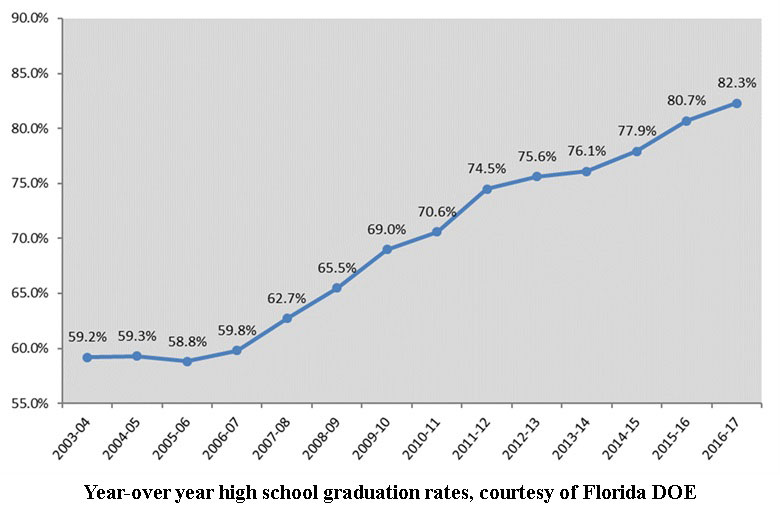
To hear the Democrats tell it, you'd think Rick Scott drove Florida education off a cliff. Have you see their latest ad, "It's School Time"?
It's a 30-second spot. Thirty seconds is just enough time to put a thought in your head, nowhere near enough time to prove the thought has any connection to reality.
The ad never claims Florida ever was "#1." -- have a look at it here. Instead, it says "We're #1" -- with the "#1" crossed out, replaced by "#40." So it feels as if Florida education went from #1 to #40 under Rick Scott. In tiny writing is the source, the U.S. News & World Report school rankings from August. Now, I'm sure that ranking exists in some edition and some context, but darned if I can find it.
What I did find is U.S. News & World Report's "Best States for Education" from 2018 showing Florida ranked 7th in education, and 15th overall -- "overall" taking into account factors like health care (which we do poorly on) and fiscal stability (which we excel on).
Seventh in education out of 50 states is a long way from 40. Even 15 is a long way from 40. This is a "pants on fire" ad plain and simple.
The ad also claims Scott subtracted $1.3 billion when he became governor. Well, yes he did during his first year in office. I can't deny it. And he did a whole lot more belt-tightening than that in 2011 to yank Florida out of a deep recession and get the economy moving again.
"The governor is being a fiscal hard-ass, setting us up for success and I thank the good Lord for it," the late Sen. Durrell Peaden, R-Crestview, told a bunch of us after a press conference in the Capitol rotunda in February 2012. I don't recall anyone in the group disapproving.
The ad also references a story from the Tampa Bay Times, the "Rick Scott negative press machine" -- which unearthed it (of course), mostly from teachers union sources -- to blame the governor for "critical teacher shortages." (I plan to adress teachers pay in a separate story.) For now, know that even the state Department of Education admits shortages exist and all 67 districts are trying to deal with them.
But here's the thing: Teacher shortages in special areas of teaching are a fact of life across the country, not just in Florida. States are squeezing out liberal arts in general. Teacher shortages exist in Florida as they do in all 50 states, for qualified teachers who specialize in STEM, English for speakers of other languages (ESOL) and students with disabilities. Meanwhile, elementary education postings often receive dozens of applications per job opening.
Now let's look at what changed after Scott's first spartan year. It's something the Democrats don't want you to look at, but we have to. Because, in spite of the first-year starvation diet -- yes, counting the minus-$1.3 billion -- state funding for Florida's K-12 public schools has increased by 3.2 billion, or 37 percent, since Scott took office.
With increasing graduation rates and policies that rank among the best in the nation, the Governor’s Securing Florida’s Future budget invests $21.1 billion in state and local funding for Florida’s K-12 public schools. That's an increase of $484.8 million in state and local funds over fiscal 2017-18. This marks the sixth straight year Scott has made record investments in state funding for K-12.
The increase of more than $484 million in total funds includes:
-
Nearly $196 million to fund new student growth of nearly 27,000;
-
$97.5 million, for a total of $162 million, in funding for school safety initiatives that promote a safe learning environment;
-
Nearly $9 million, for a total of more than $54 million in funding for the Teacher Classroom Supply Assistance Program;
-
Nearly $70 million for the mental health assistance allocation; and
-
$112.6 million for various education initiatives included in the FEFP, like transportation and instructional materials.
This is historic funding. What it equates to is $7,408 per student, an increase of $101.50 per student over current-year spending.
This is the highest total funding, state funding and per-student funding for K-12 in Florida’s history.
All of this information, with state comparisons and more, is readily available from the Florida Department of Education.
If you think Rick Scott has been cheap with Florida education, look at his funding proposals in each budget year. Click here and scroll to the bottom of the page. You'll find links to his previous budgets which detail his education recommendations. You may still say, "Not enough!" But at least you'll have a better idea of what really happened in seven years.
Overall student achievement? It ranks fourth in the nation, according to Education Week’s 2018 Quality Counts report. Florida outperformed other states in "every measure of achievement gains, poverty gap and Advanced Placement," which constituted 14 of the 18 comparisons, according to the report unveiled Sept. 6.
On the 2017 NAEP (National Assessment of Educational Progress), Florida made more progress than any other state. Florida is the only state that showed statistically significant improvement on three of the four assessments (grades 4 and 8 math and grade 8 reading). Florida is also the only state that showed statistically significant improvement in grade 4 and grade 8 math between 2015 and 2017.

In 1998, Florida students scored near the bottom of the nation in student achievement in reading.
In 2002, Florida implemented a comprehensive K-3 reading policy to identify struggling readers, provide reading interventions for those readers, engage parents and end social promotion.
Now we've gone above and beyond. Florida’s 4th graders have improved by more than two grade levels (23 points from 1998 to 2017) on the NAEP in reading performance. Black and Hispanic students have improved by more than 2 1/2 grade levels (26 and 27 points respectively) in reading. And low income students have improved by nearly three grade levels (29 points) in reading.
Florida fourth graders ranked 5th in the nation on NAEP 2017, outperforming the national average of public school students by 7.5 points.
Then there's the graduation rate.
Florida's high school graduation rate was in the toilet when I arrived in Florida in 1977 -- ranked among the bottom 10 states. That was not under Rick Scott. That was not under a Republican governor or a Republican Legislature. Now look at it. (See the chart at the bottom of the page). For the 2016-17 school year, the statewide graduation rate rose to 82.3 percent, a 14-year-high, plus an increase of 23.1 percent since 2003-04 and 1.6 percent over last year. Here's a breakdown:
-
The statewide graduation rate among black or African American students increased by 10.2 percent over the last five years, rising from 64.6 percent in 2012-13 to 74.8 percent in 2016-17.
-
The statewide graduation rate among Hispanic students increased by 6.4 percent over the last five years, rising from 74.9 percent in 2012-13 to 81.3 percent in 2016-17.
-
The statewide graduation rate among economically disadvantaged students increased by 9.8 percent, rising from 67.0 percent in 2012-13 to 76.8 percent in 2016-17.
You may also remember that U.S. News & World Report just ranked Florida higher education #1 in the nation. It happened because a Republican Legislature wanted Florida represented by quality universities and a Republican governor cared about making a college degree affordable for all Floridians.
Certainly not everything is rosy. Florida’s public schools receive some of the lowest funding of any state school system in the country. The state allocates only 2.7 percent of its taxable resources to school funding, well below the 3.3 percent average funding across all state school systems. Partially as a result, annual per-pupil education spending is only $9,737, or about $2,800 less than the typical spending nationwide.
Yet, in spite of potentially inadequate funding -- at least, by some measures -- Florida’s school system is recognized as relatively successful. For example, it is fifth in number of high advanced placement test scores of any state relative to the number of 11th and 12th-grade students in the state. Improving markedly in recent years, between 2000 and 2014, the number of high advanced placement test scores per 100 juniors and seniors climbed by 28.2 percent, the third greatest improvement of any state.
Bill Nelson's latest education ad might fool some of the people, especially the ones who weren't living in Florida 25 or more years ago when education in many districts was truly alarming. But Nelson and the Florida Democratic Party know how dishonest it is. 
Reach Nancy Smith at nsmith@sunshinestatenews.com or at 228-282-2423. Twitter: @NancyLBSmith


